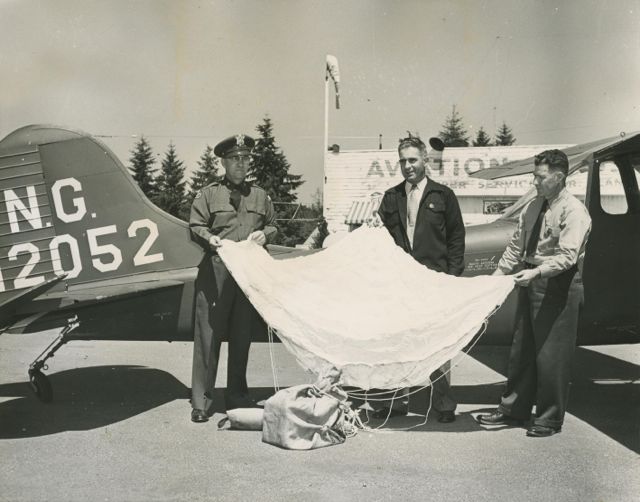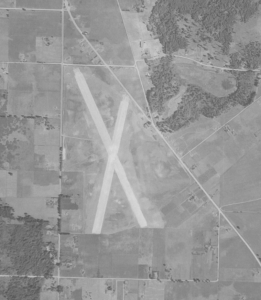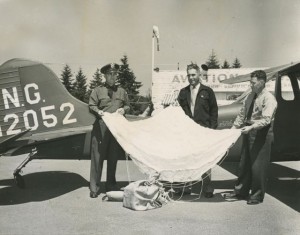
By Emmett O’Connell
 The Olympia Airport was first constructed in 1928 a year after members of the Olympia Chamber of Commerce purchased the site for the express purpose of building an airfield. The late 1920s (the era of Linberg crossing the Atlantic) was a time when communities fought to make their mark in a world connected by airplanes.
The Olympia Airport was first constructed in 1928 a year after members of the Olympia Chamber of Commerce purchased the site for the express purpose of building an airfield. The late 1920s (the era of Linberg crossing the Atlantic) was a time when communities fought to make their mark in a world connected by airplanes.
The construction and purchase from the original Chamber of Commerce buyers was financed by a $35,000 bond issue put forward by the City of Olympia. Early on, the city attempted to cement the airport’s importance by building a night beacon, which aided 24-hour flights.
But, according to the historic inventory narrative for the airport, “Unfortunately the Superintendent of Lighthouses, then in charge of airport lighting told the city that beacons were to be at 50-mile intervals and beacons were already in place at Tacoma and Chehalis, putting Olympia out of the running.”

This era of quickly establishing airports (or rather air strips as they’d now be understood) seems very similar to the time 50 years earlier when cities would fight for railroads. Air transport was a dawning economic engine, and Olympia wasn’t eager to be left behind.
It’s interesting to note that both Olympia’s first railroad and airport were both local efforts. After being spurned by national-railroad interests, Olympians had paid for their own spur line in the 1870s.
The mid-1930s were a time of growth for the airport when a hangar was built (and expanded in 1937). In 1935 Jack Cram, who supervised the building of the hangar, also taught flying and gave chartered flights. The expansion of the hangar was a joint effort by the state Highway Department, the local chamber of commerce and the Works Progress Administration. Also in 1937 the grass landing strips were finally graded and paved (also by the Highway department).
Soon after the modern hangar and paved landing strips were ready, the Olympia Airport turned its sights on the looming war. The airport (along with classes held at Saint Martin’s College as noted in this Thurston Talk piece) was a site of the Civilian Pilot Training program. This federal effort was meant to increase the number of trained pilots and associated personnel. With similar training programs being started by European countries, the United States matched with their own training program. By the close of the program, Olympia had trained 1,150 professionals.
When war officially broke out in 1941, the airport became a way station to the Pacific front. Officially a satellite operation of the army’s McCord airfield, it also served as temporary home for units such as the 37th Flying Training Squadron, a part of the 55th Pursuit Group. The squadron called Olympia home from July 1942 to August 1943. The 37th seems typical for what kind of home Olympia was for air units of the era. The 37th, constituted of P-43 Lancers and later refitted with P-38H Lightning interceptors, was activated at an airbase in the San Francisco Bay area. The unit then trained on their way up to the west coast to Olympia before heading off to England.
The City of Olympia also took advantage of the war use of the airport by issuing additional bonds to expand the facility’s land base.
The airport’s last service to the war was as a location for surplusing old materials before it was given back to the City of Olympia in 1947.

After the war, a series of private operators managed activities at the airport, despite public ownership. The first post war operator was H. A. Buroker and Aviation Industries Company, who offered “a GI flight school and regular services as did a number of other former pilot trainers located at the facility.” In 1950, after a downturn in activity, another operator named Capital Airways took over. Capital Airways was followed by several others until the city turned the airport over to the Port of Olympia in 1963.
The current Olympia Airport is operated on 835 acres with over a 400-acre adjoining commercial campus. Current flight activities at the airport include an air ambulance, Department of Natural Resources aerial firefighting, fixed wing and helicopter flight, the Washington State Patrol, and the Olympic Flight Museum.
Works cited and additional reading:
Tumwater Historical Association: Olympia’s Airport in Tumwater
DAHP Historic Listing for the Olympia Airport
Shanna Stevenson, The Port of Olympia : a 75 year history, 1922-1997 (1997)
Shanna Stevenson, Superior Shipping Service, a history of the Port of Olympia (1982)


















































